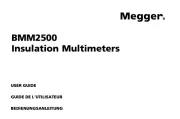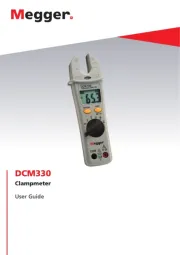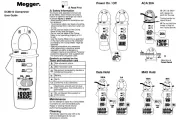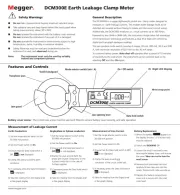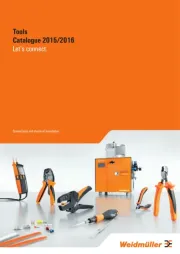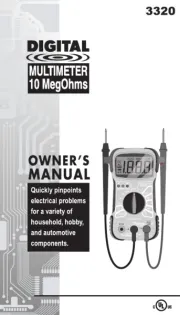
DESCRIPTION
BESCHREIBUNG
DESCRIZIONE
DESCRIPCIÓN
FACE AVANT – FRONT PANEL
VORDERSEITE
FACCIA ANTERIORE - FRONTAL
1. Capteur détection de tension sans contact FR
-Contact free voltage detection sensor GB
Spannungsprüfer berührungslo D
Sensore rilevazione di tensione senza contatto I
Sensor detección de tensión sin contacto E
2. Barre lumineuse d’indication de tension FR
Voltage indication light bar GB
Spannungsanzeige D
Barra luminosa indicante la tensione I
Barra luminosa de indicación de tensión E
3. LCD FR
LCD GB
D LCD
I LCD
E LCD
4. Touche de sélection de mesure FR
Measurement selection key GB
Messwahltaste D
Tasto di selezione di misura I
Tecla de selección de medida E
5. Commutateur FR
Switch GB
D Umschalter
Commutatore I
Conmutador E
6. Torche lumineuse FR
Flashlight GB
D Stablampe
I Torcia luminosa
E Torcha luminosa
7. Touche pour actionner la torche lumineuse FR
Flashlight On key GB
Taste für die Stablampe D
Tasto per azionare la torcia luminosa I
Tecla para accionar la torcha luminosa E
8. Touche HOLD FR
HOLD key GB
D Taste HOLD
I Tasto HOLD
E Tecla HOLD
9. Trappe à piles FR
Battery compartment GB
Batteriefach D
Sportello delle pile I
Tapa de pilas E
10. Pointes de touches solidaires du testeur FR
Probe tips on the tester itself GB
Tastspitzen in Gerät integriert D
Punte di contatto unite al tester I
Puntas solidarias del comprobador E
LCD
1. Diode FR
Diode GB
D D iode
I Diodo
E Diodo
2. Continuité FR
C ontinuity GB
D Durchgang
I Continuità
E Continuidad
3. Maintien de l’afficheur HOLD FR
Display unit HOLD GB
ld- D Ho Funktion
Mantenimento del display HOLD I
Fijación del visualizador E
4. Indicateur usure pile FR
Battery low indicator GB
Batteriezustand D
Indicatore usura pila I
Indicador de desgaste de la pila E
5. Valeur mesurée FR
Value measured GB
D Messwert
Valore misurato I
E Volor medido
6. ension T FR
Voltage GB
D Spannung
I Tensione
E Tensión
7. Courant FR
Current GB
D Strom
I Corrente
E Corriente
8. Résistance FR
Resistance GB
D Widerstand
Resistenza I
Resistencia E
9. Gammes automatiques FR
Automatic ranges GB
Automatische Bereiche D
Gamme automatiche I
Gamas automáticas E
10. Alternatif FR
AC GB
WS D
I Alternata
E Alterna
11. Continu FR
DC GB
D GS
I Continuita
E Continua
12. Polarité négative FR
Negative polarity GB
Negative Polarität D
Polarità negativa I
Polaridad negativa E
FRANÇAIS
Félicitations pour l’achat de ce multimètre de poche
numérique.
C’est un appareil d’utilisation simple faisant partie de
la gamme CHAUVIN ARNOUX permettant d’effectuer -
les mesures de grandeurs suivantes
résistance, test de continuité et de diodes.
PRÉCAUTIONS D’EMPLOI
Li
sez les instructions de sécurité suivantes avant
d’utiliser l’appareil. Il est impératif de suivre les
indications précédées du symbole .
Reportez-vous aux messages de sécurité afin d’éviter
les accidents corporels, tels que les brûlures et chocs
électriques.
NORMES :
Catégorie de surtension IV, Tension max. d’entrée :
600 V.
Attention !
Cet appareil n’est pas un Vérificateur
d’Absence de Tension ou un Détecteur de Tension au
sens de l’UTE C18510
CATÉGORIES DE MESURE (IEC -2- 61010 033)
Catégorie de mesure II :
La catégorie de mesure II est applicable aux circuits
de test et de mesure connectés directement aux
points d’utilisation (prises de courant et autres points
similaires) du RESEAU basse tension. Au minimum,
deux niveaux de dispositifs de protection contre les
surintensités sont supposés être présents entre le
transformateur et le point de mesure.
Exemple : Les mesures sur les CIRCUITS RESEAU
des appareils électroménagers, des outils portables et
autres appareils similaires.
Catégorie de mesure I :II
La catégorie de mesure III est applicable aux circuits
de test et de mesure connectés aux parties de
l'installation du RESEAU basse tension du bâtiment.
Au minimum, un niveau de dispositifs de protection
contre les surintensités est supposé être présent entre
le transformateur et le point de mesure.
Exemple : Les mesures sur les tableaux de
distribution (y compris les compteurs divisionnaires),
les disjoncteurs, le câblage y compris les câbles, les
barres-
bus, les boîtiers de dérivation, les
sectionneurs, les prises de courants dans l'installation
fixe, et les appareillages à usage industriel et autres
équipements tels que les moteurs branchés en
permanence sur l'installation fixe.
Catégorie de mesure IV :
La catégorie de mesure IV est applicable au x circuits
de test et de mesure connectés à la source de
l'installation du RESEAU basse tension du bâtiment.
Cette partie de l’installation peut ne pas avoir de
dispositifs de protection contre les surintensités entre
le transformateur et le point de mesure.
Exemple : Les mesures sur des dispositifs installés
avant le fusible principal ou le disjoncteur de
l'installation du bâtiment.
POUR TRAVAILLER EN SÉCURITÉ :
- Soyez particulièrement vigilants pour des tensions
supérieures à 30VAC RMS et 50VDC.
- Ne travaillez jamais au delà des plages de tension-
max. indiquées.
- Vérifiez l’état de fonctionnement des cordons et de
l’appareil.
- Ne pas utiliser l’appareil si celui ci est détérioré.-
- Connectez en premier la pointe de touche noire, puis
la rouge.
- Déconnectez en premier la pointe de touche rouge,
puis la noire.
- Les doigts ne doivent jamais dépasser la garde.
- Déconnectez
les cordons préalablement au
changement de fonction.
- Vérifiez l’absence
de tension avant d’utiliser la
fonction continuité, résistance ou test diodes.
- Contrôlez la concordance entre la position du
commutateur et le choix de la fonction.
- N’utilisez jamais le testeur sans gants pour
électriciens et autres équipements de sécurité
préconisés par la législation.
- N’
utilisez jamais dans un environnement
humide/poussiéreux.
- Ne changez pas les piles lorsque les cordons
sont connectés.
- Ne démontez pas le boîtier, seule la trappe à
piles peut être ouverte.
GARANTIE
Ce matériel est garanti contre tout défaut de
matière ou vice de fabrication, conformément aux
conditions générales de vente. Durant la période
de garantie (1 an), l’appareil ne peut être réparé
que par le -constructeur, celui ci se réservant la
décision de procéder soit à la réparation, soit à
l’échange de tout ou partie de l’appareil.
En cas de retour du matériel au constructeur, le
transport aller est à la charge du client.
La garantie ne s’applique pas suite à :
- une utilisation impropre du matériel ou par
association -de celui ci avec un équipement
incompatible.
- une modification du matériel sans autorisation
explicite des services techniques du constructeur.
- une intervention de réparation effectuée par une
personne non agréée par le constructeur.
- l’adaptation à une application particulière, non
prévue par la définition du matériel ou par la notice
de fonctionnement.
- un choc, une chute ou une inondation
MAINTENANCE
DÉBALLAGE ET RÉ- EMBALLAGE
L’ensemble du matériel a été vérifié
mécaniquement et électriquement avant
l’expédition. Toutefois, il est conseillé de procéder
à une vérification rapide pour détecter toute
détérioration éventuelle lors du transport. Si tel
était le cas, faites alors immédiatement les
réserves d’usage auprès du transporteur.
En cas de réexpédition, utilisez l’emballage
d’origine et indiquez, par une note jointe à
l’appareil, les motifs du renvoi.
VÉRIFICATION MÉTROLOGIQUE
Comme tous les appareils de mesure ou d’essais,
une vérification périodique est nécessaire.
Nous vous conseillons une vérification annuelle de
cet appareil. Pour les vérifications et étalonnages,
adressez-vous à nos laboratoires de métrologie
accrédités COFRAC ou aux centres techniques
MANUMESURE.
Renseignements et coordonnées sur demande :
Tél. : 02 31 64 51 55 Fax : 02 31 64 51 72-
ENTRETIEN
Périodiquement, nettoyez votre multimètre avec
un tissu humide imprégné d’eau savonneuse.
N’utilisez pas de matières abrasives ou contenant
des solvants.
STOCKAGE
Si vous n’utilisez pas votre multimètre pendant
une période supérieure à 60 jours, retirez les piles
et stockez-les séparément.
DESCRIPTION
FONCTIONNELLE
DÉTECTION DE PHASE AC SANS CONTACT
Attention : Testez l’appareil sur le secteur avant
utilisation pour vous assurer du bon état de
fonctionnement de l’appareil.
Cette fonction marche, l’appareil étant éteint ou
allumé et quelque soit la position du commutateur.
- Mettre le capteur de phase AC sans contact
(rep. 1) à proximité immédiate de la prise, du
câble ou du connecteur à tester.
- La barre lumineuse d’indication de tension
(rep.2) s’allume en cas de présence d’une tension
alternative comprise entre 100 et 600VAC par
rapport à la terre.
- Cette fonction permet ainsi de repérer la phase
d u neutre.
Attention : la présence champs électrostatiques
(frottement...) peut occasionner l’allumage
intempestif de la barre lumineuse.
De même, la sensibil té de l’appareil en présence i
de champs électromagnétiques importants (dans
des armoires électriques par exemple) peut
conduire à un diagnostic erroné de présence de
tension. Pour isons, utilisez un appareil ces ra
conforme à la norme IEC 61243 -3 pour effectuer
vos opérations de détection de tension, par
exemple le C.A 760.
MESURE DE TENSION ALTERNATIVE OU
CONTINU
- Positionnez le commutateur sur la fonction «V».
La prise de mesure en alternatif est la prise de
mesure par défaut.
Appuyez sur la touche 2nde AC/DC pour passer de
l’alternatif au continu et pour retourner ensuite à
l’alternatif.
- Appliquez la pointe de touche noire sur un pôle,
puis la pointe de touche rouge sur le second pôle.
- Lisez la valeur sur l’afficheur.
- Enfin, retirez la pointe de touche rouge, puis la
noire.
MESURE DE COURANT ALTERNATIVE OU
CONTINU
- Positionnez le commutateur sur la fonction «mA»
puis sur «µA» si vous désirez mesurer des µA.
La prise de mesure en alternatif est la prise de
mesure par défaut.
Appuyez sur la touche 2nde AC/DC pour passer de
l’alternatif au continu et pour retourner ensuite à
l’alternatif.
- Appliquez la pointe de touche noire sur un pôle,
puis la pointe de touche rouge sur le second pôle.
- Lisez la valeur sur l’afficheur.
- Enfin, retirez la pointe de touche rouge, puis la
noire.
Nota : l’appareil est protégé par un fusible
électronique automatiquement réarmable 600V -
200mA.
MESURE DE RÉSISTANCE «
»
- Travaillez hors tension.
- Positionnez le commutateur sur « Ω ».
- Appliquez les pointes de touche rouge et noire sur
l’objet à mesurer.
- Lisez la valeur sur l’afficheur.
Nota : l’appareil est protégé jusqu’à 600VRMS sur
cette entrée.
CONTRÔLE DE CONTINUITÉ
- Travaillez hors tension.
- Positionnez le commutateur sur « Ω ».
- Appuyez successivement sur « 2
nde AC/DC »
jusqu’à ce que « » apparaisse.
- Appliquez les pointes de touches rouge et noire
sur le circuit ou le conducteur à mesurer.
TEST DE DIODE
- Travaillez hors tension.
- Positionnez le commutateur sur « ». Ω
- Appuyez successivement sur « 2
nde AC/DC »
jusqu’à ce que « » apparaisse.
- Appliquez les pointes de touche rouge et noire sur
le circuit ou le conducteur à mesurer.
FONCTION HOLD
- Connectez les pointes de touche.
- Appuyez sur la touche HOLD pour figer l’écran.
- Le texte « HOLD » apparaît à l’écran et le buzzer
retentit.
- Retirez les pointes de touche.
- Lisez la valeur sur l’afficheur.
FONCTION ÉCLAIRAGE « TORCHE »
LUMINEUSE
Cette fonction marche, l’appareil étant allumé et
éteint, quelque soit la position du commutateur.
- Appuyez et maintenez la touche (rep.7) enfoncée
tant que vous désirez que la torche lumineuse (rep.
6) reste allumée.
AUTO POWER OFF
- 3 Le C.A 70 s’éteint automatiquement 15’ après la
dernière opération.
-
Toute action sur la touche HOLD ou le
commutateur repousse ce délai.
REMPLACEMENT DES PILES
Si le symbole «batterie» apparaît, les piles sont trop
faibles. Remplacez les par deux piles AAA 1.5V :-
- Déconnectez les pointes de touche.
- Positionnez le commutateur sur OFF.
- Retirez la vis du volet pile, puis remplacez les
piles et refermez et revissez le couvercle (rep. 9).
CARACTÉRISTIQUES
GÉNÉRALES
SPÉCIFICATIONS
- Méthodes de mesure : moyenne
- -Bande passante : 40 400Hz
- Impédance d’entrée (VAC & DC) : 7.5MΩ
- Afficheur : 1999 points
- Sélection de gammes : automatique
- Dépassement de gammes : affichage «OL» en
résistance.
- Indication de polarité : signe «-»
- Indication d’usure piles: symbole «pile faible»
- Fréquence d’échantillonnage : env.2 fois par s.
- Environnement de travail : 0 à 40°C; RH<80%
absence de condensation.
- Conditions de stockage : -
RH<70%, absence de condensation.
- Alimentation électrique : 2 piles AAA 1.5V.
- Masse : env. 145g.
- Dimensions : 104(L) x 55(l) x 32.5(H)mm
SPÉCIFICATIONS TECHNIQUES
Métrologie
Conditions de référence : 18°C – 28°C ; RH <
80%, absence de condensation.
Norme : -1 IEC 61010
- IEC 61010 031
-2- IEC 61010 033
POUR COMMANDER
Multitesteur C.A 703 Z P01191740
Livré avec deux cordons solidaires à pointe de
touche, 2 piles 1.5V AAA et cette notice de
500V fusible
électronique
500V fusible
électronique
Multimètre de poche numérique
Digital Pocket Multimeter
Digitalen Taschen-Multimeters
Multimetro tascabile digitale
Multímetro de bolsillo digital
E N G L I S H
E S P A N O L
I T A L I A N O
D E U T S C H
Us er’s Manual
Manua l de Ins trucc ione s
L ibre tto d’Is tru zioni
B edie nungs anle itung
Code 691589A00_Ed04
Deutschland
Ohmstraße 1 77694 KEHL /RHEIN-
Tél : (07851) 99 26- - 0 Fax : (07851) 99 26-60
España
C/ Roger de Flor N°293 Planta 1-
08025 BARCELONA
Tél : 902 20 22 26 Fax : 934 59 14 43-
Italia
Via Sant’ Ambrogio, 23/25
20846 MACHERIO (MB)
Tél : (039) 245 75 45 Fax : (039) 481 561-
Österreich
Slamastrasse 29/2/4 - 1230 WIEN
Tél : 01 61 61 9 61 Fax : 01 61 61 9 61 61-0 -
Schweiz
Moosacherstrasse 15 8804 AU / ZH-
Tél : 044 727 75 55 Fax : 044 - 727 75 56
UK
Unit 1 Flagship Sq Shaw Cross - - Nelson Ct -
Business Pk - Dewsbury, West Yorkshire - WF12 7TH
Tél : 01924 460 494 Fax : 01924 455 328-
Middle East
P.O BOX 60- - 154 1241 2020 Jal el dib- BEIRUT
Tél : (01) 890 425 - Fax : (01) 890 424
China - Shanghai Pujiang Enerdis Inst. CO. LTD
3 Floor, Buildind 1 n°381 Xiang De Road
Hongkou District - 200081 - SHANGHAI
Tél : +86 21 65 21 51 96 Fax : +86 21 65 21 61 07-
USA - d.b.a AEMC Instruments
200 Foxborough Blvd MA 02035- Foxborough -
Tél : (508) 698 Fax : (508) 698-2115 - - 2118
190, rue Championnet 75876 PARIS Cedex 18 - - FRANCE
Tél. (33) 01 44 85 44 85 Fax (33) 01 46 27 73 89-
http://www.chauvin arnoux.com-











